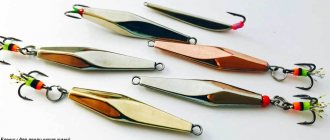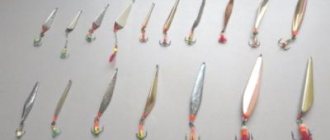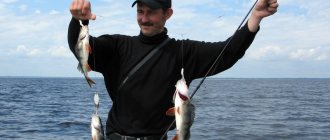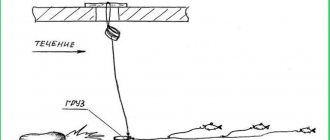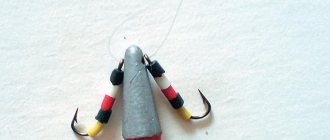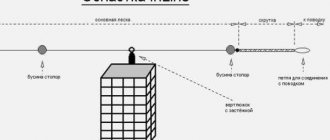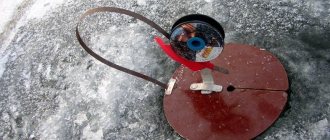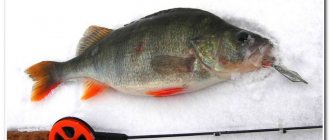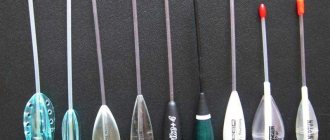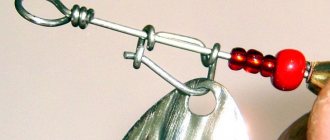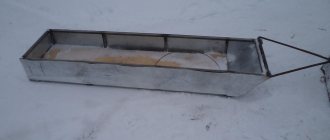Baldu fishing is known as a fairly old method of fishing, which in its principle and technique has survived unchanged to this day. The only difference was the improvement of the equipment, which today is assembled from modern fishing materials and accessories. Efficiency and versatility helped this interesting method of hunting not to get lost among the many types of fishing, and such qualities are always valuable in fishing and give positive results in the form of catches, regardless of the fishing conditions.
In the further material of the article, we will look at the Balda fishing tackle in its design solutions, and also discuss the technique of fishing with this ancient equipment based on the conditions on the reservoir and the seasons of the year. In addition to the information listed, the angler will learn about the types of fish for which the equipment works best. We also note the fact that the article will be useful for fans of both winter ice fishing and the large army of summer fishermen.
What is a fishing rod
Balda tackle is an artificial bait, largely positioned as a tool for catching predatory fish. Characterizing the bait, we can say that it is something between a vertical spoon and a jig, and the bait fishing technique has borrowed most of its techniques from these methods. The main body of the equipment is a weight that has a fastening eyelet or hole in its upper part for winding the fishing line. The type of cargo varies from cylindrical to drop-shaped or pear-shaped. The weight is strung on a fishing line, and a single hook is mounted on its sides, also freely threading them through the fastening eyelet onto the fishing line.
The weight and hooks hang on a blind loop, at the base of which a tie is formed to connect the equipment with the main fishing line. In its appearance, the Balda bait imitates a small insect; this imitation is especially noticeable when tossing the equipment, when the hooks slide up the fishing line, reminiscent of the movement of the legs of a living object. To make it attractive, multi-colored beads are strung on the hooks, and the load itself can be painted in a color that is interesting for the fish being caught.
Winter fishing for perch with a spinner
The Bald bait for perch works effectively in winter, as it combines several stimuli in its game that arouse the curiosity of the striped fish:
- Dirty as a result of tapping on the bottom.
- Free-sinking hooks in a loop of fishing line with fibers (beads), which are the point of attack.
- Actually, water vibrations resulting from the movements of the boom during wiring.
This method of catching perch in winter has long proven itself in our reservoirs. More details about the winter technique of catching perch on a bulldozer are described in the article:

Balda for fishing - varieties
Even such narrowly targeted gear has two types of bait assembly, which differ in their design features from each other, and therefore have a different pattern of play when retrieving.
The first and most common type of beam has a so-called prefabricated structure, when all three elements, two hooks and the weight itself are independent of each other and strung alternately on a blind line loop, in which the sinker occupies a central position between the hooks. For this type of rig, the sinker has only one attachment point at the top of the sinker.
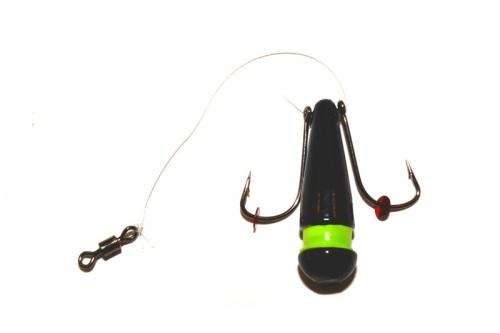
The second type of bait is distinguished by the structure of the load, which, in addition to the main fastening element, has two additional loops on its sides, intended for mounting hooks. This type of equipment can be located either in a blind loop or simply at the end of the tackle cord. This type of boom can only be used on hard bottom soils, since when inserted into silt, the sinker along with the hooks will sink, going into the silt, and the predator will not notice it, unlike the first design, the hooks of which will remain on the surface, sliding freely in a loop.
Rod for bulldozer
The rods most often used are not very expensive composite rods with a test weight of around 40...80 grams. At the same time, no one forbids using a more expensive, and therefore lighter, carbon fiber rod with the same test. For those who are just beginning to understand all the intricacies of fishing, let me explain that the rod test determines the maximum weight of the casting equipment. With an upper limit of 80 grams, it is worth limiting the weight of the equipment to 70 grams, so that the rod has a small margin of safety. The next important factor is the length of the rod and there are two main directions here. First, you will be fishing from the shore, in this case you should choose a rod no shorter than 3.3 meters, but you should not take a very long one, because It is much more difficult to manipulate a long stick. Secondly, if you are fishing from a boat, then a rod 2.1…2.4 meters long will suffice. You don’t need to cast far from the boat, you can cast right under the side, so a short rod will suffice.
The next important factor that should not be neglected is the structure of the rod. For Balda, they choose rods with a fast action (that is, rigid), this was once recommended to me and this is how it was justified. In order to quickly control the equipment, you need a fairly rigid rod so that the angler’s actions are immediately transmitted to the equipment. This provides clear hooks and, in general, good control of the tackle as a whole. You can, of course, choose a medium action, if it seems that the rod is very stiff and the fish comes off the hook for this reason.
What time of year can you use Balda?
Fishing with balda can be carried out under any conditions, both during the open water season and when ice covering is installed on reservoirs. Many fishermen mistakenly believe that they can only use the cannon for fishing in winter when fishing from ice, which is a complete misconception. In summer, the tackle is no less effective in its catchability and is especially convenient when fishing in heavily overgrown reservoirs, where the use of other fishing methods is completely impossible.
In open areas of water, spot fishing is carried out in places of bottom anomalies and obviously known areas of water areas where there are accumulations of fish - in snags, near fallen trees and near flooded objects from the results of construction and shipping activities. Baldoy is caught both from the banks and from boats, using a technique similar to fishing with a nod or a summer jig. In winter, fishing is much more convenient, because on the ice you can get to any promising point and tap quite accurately, as in fishing slang they talk about the technique of fishing with this tackle, an interesting place.
Fishing technology
The most popular technology today is the classic fishing technique. The angler will need to actively play with the bait, constantly raising and lowering the heavy sinker. When the weight hits the bottom, it creates a cloud of turbidity, which attracts predatory fish, and the constant movement of the bulldozer forces a hungry predator to actively peck at such bait.
Advantages of the “balda” tackle:
- Versatility.
- Simplicity of equipment.
- Efficiency.
- Possibility of doing it yourself.
It has been noted that when ice fishing, the greatest efficiency is shown by using a canister on a sandy and muddy bottom. But on rocks, such tackle is less effective; it even scares away fish when the heavy sinker hits the rocky bottom.
In the summer, the bulldozer can be used as a classic spinning rod, replacing spoons and wobblers, when the fisherman throws a heavy sinker with an imitation bait, and then quickly retrieves the bait, thereby fishing deep holes or areas along coastal vegetation.
What kind of fish is this bait used for?
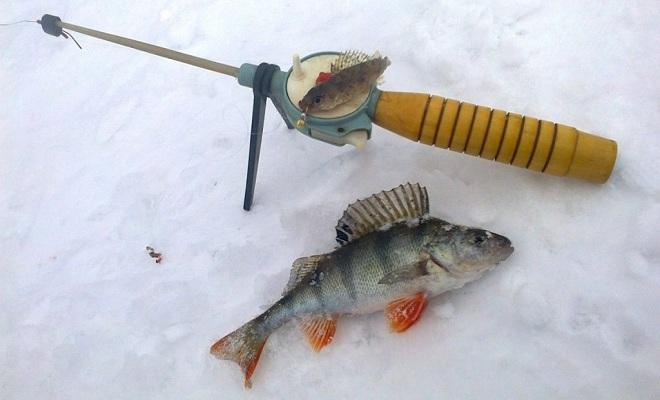
Regardless of the fishing time, the balda is considered a universal tool with which you can catch not only predatory fish, but also most peaceful species of fish. This is due to the fact that, imitating an underwater insect or beetle, the bait arouses the interest of any fish, being a familiar and familiar food object. In the classics, the bulldozer is a direct tool for catching perch and pike perch. By manipulating the dimensions of the bait, the volume of the load and the size of the hooks, pike are successfully caught with the tackle. In addition to predators, it is quite effective to catch bream, roach, ruffe and crucian carp using small bait sizes. With a certain fishing technique and equipment, this type of bait is suitable for catching grayling. It is worth noting that despite such a decent list of fish species possible for catching, fishing techniques and strategies remain practically unchanged, and this fully characterizes the versatility of the equipment.
Do-it-yourself bulldozer
The most popular metal for making bass fishing rods is lead. A sinker made of this metal is easily poured into a special mold.
For targeted catching of perch with this bait, its weight and length should not be too large. Perch does not “like” large baits, and even a trophy-sized perch can bite on a 5 cm long tackle.
Lead making instructions:
- In order to pour the bait base , you should melt the lead in a small metal container and pour it into a tube of suitable diameter, which is installed vertically in the sand.
- The tube should consist of soft metal so that after the lead has cooled, there will be no difficulty in removing the sinker from the mold.
- In the upper part, use a 2 mm drill to drill a hole across the sinker. Be sure to chamfer both sides of the drilled through hole. This must be done to eliminate the resulting sharp edges that can damage the fishing line.
When working with lead, care should be taken due to the high toxicity of the vapors of this metal.
You can make a sinker from a piece of steel reinforcement, which should then be coated with a layer of shiny metal using the electrolysis method. Thus, it is possible to coat a steel surface with gold, silver or copper.
All smelting work should be carried out only in the open air.
You can use wooden molds to pour out the sinker:
- A blind hole of the required diameter and depth is drilled into a piece of hardwood .
- Then it is freed from sawdust and the recess is filled with molten lead.
- After the metal has cooled, it can be removed from the mold by turning the piece of wood over. If the finished lead part does not separate from the wooden mold, then the wood should be carefully split so as not to touch the lead blank.
But doing this is completely optional; the main purpose of the sinker is to hold the bait strictly in a vertical position, even in the presence of a strong current. In addition, the sinker lifts turbidity from the bottom into the water column.
Hooks are suitable for mounting this tackle only with eyes; tackle with blades is not suitable for mounting this bait.
To attract a predator, brightly colored cambric or beads are placed on the fore-end.
The final stage of installation of this tackle is to thread the line through the sinkers and hooks in the following sequence:
- First hook.
- Sinker.
- Second hook.
Then a loop is formed from the fishing line and a knot is securely tied, which prevents the diameter of this loop from changing and eliminates the possibility of this bait being untied.
This tackle can be made not only from lead , but also other metals, the mass of which allows you to reliably hold the bait even in the presence of a strong current in one place.
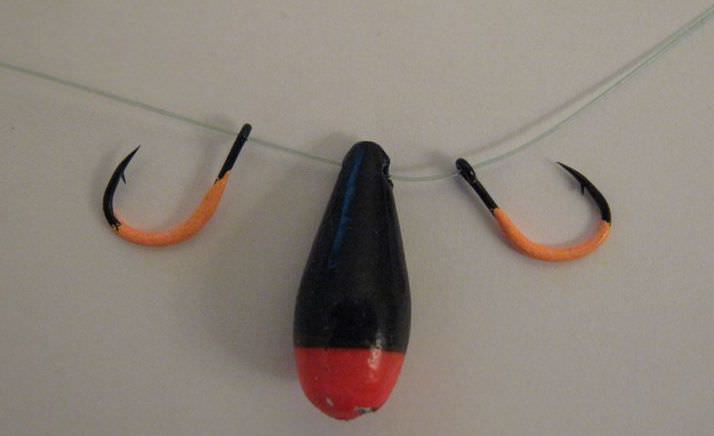
In the case when it is necessary to make a balda, and the fisherman does not have a suitable lead sinker at his disposal, then a large nut can be used as a weight. Of course, fishing for too long with such gear is impossible due to the presence of threads in the inner diameter of the nut.
The thread will act on the fishing line like a rasp when using this method of perch fishing, but in cases where there is no alternative, it will be quite suitable for this purpose. If you use a chrome-plated nut that will shine under water, then the genuine interest of such gear among predatory fish is almost guaranteed.
https://www.youtube.com/watch?v=ND6uaR7r89I
How to fish with bullfish
Fishing on a bulldozer has a fairly clear and simple principle. When the bait, or rather its weight, is placed at what the fisherman thinks is a promising stopping point, they hit the bottom, raising clouds of turbidity, which arouses interest in any fish, provoking it to approach the tool’s operating area. Further, noticing a game that imitates an insect, the fish goes out to attack an attractively behaving object and in this way ends up self-hooking on the fisherman’s hook. But like any other type of fishing, this method of catching a trophy has its own nuances related to the wiring technique and the equipment of the rod, which will ensure the supply of equipment to the fishing site, maintain the parameters necessary for the animation of the bait, and also help to fish out the caught trophy. We will talk about the nuances of fishing in different conditions in continuation of our material.
Fishing in winter
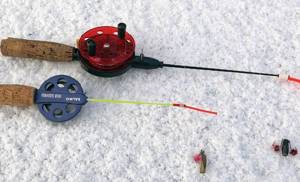
Winter fishing with balda is more widespread than fishing with this bait in open water, and this is due precisely to the accessibility of access to promising fishing points. To make it easier to work with bait, use winter fishing rods with a hard plastic whip, which ensures clear play and reliable hooking of fish. The size of the winter fishing rod directly depends on the weight of the rod used. Balalaika type fishing rods are used to catch small fish. For catching pike and pike-perch on a massive-sized cannon, a winter spinning rod with a whip of 30–50 cm is quite suitable.
When fishing on the balda in winter, use nylon fishing lines with a thickness of 0.12-0.25 mm, installing fluorocarbon leashes for pike, which do not hamper the play of the bait so much. Do not stay on one hole for more than two to three minutes, making five to seven cycles of playing with equipment. Active fish, even during this short period of time, will detect their presence in the fished area by biting.
Important! For passive fish, hooks must be equipped with bait; most often this role is played by bloodworms, maggots or burdock worms.
When fishing with predatory fish, it is necessary to have a hook, which helps in landing and removing fish caught by the cannon from the hole.
Fishing with bullfish in summer
In open water, hunting with a cannon can begin after the ice melts, fishing in the coastal zone in shallow waters. But the best results are obtained when fishing with balda in the summer, when reservoirs are covered with a dense carpet of surface aquatic vegetation. It is more effective to fish from a boat, equipping a fly rod or Bolognese rod with a nod mounted on a quiver tip. To install the equipment, carbon fiber telescopic fishing rods 3–4 meters long are used. Monofilament fishing lines with a diameter of 0.2-0.3 mm are used as the main cord.
With the help of such simple gear, the simulator is delivered to the gaps between the vegetation, carrying out 5-7 cycles of play and, if there are no bites, they move to another place. Just like in winter, when fish activity is low, you can put bloodworms, maggots or pieces of dung worm on the hooks. In this way, hunting for bully in promising places can be carried out right up to the freeze-up.
Design features
The appearance and play of the bully resemble a beetle swarming in the bottom, which attracts fish so much. A lead cone is used as a sinker. Since the purpose of fishing is perch, it makes no sense to use more expensive metals. At the top of the figure there is an eyelet through which a fishing line up to 0.2 mm thick is passed. Hooks are mounted on both sides; the fore-end should be long, making it easier to remove them from the fish’s mouth. Beads of any color must be attached to it, repeating the colors of various insects.
Small red balls are often used, imitating bloodworms - the main food supply of the striped predator. The sinker plays the main role in attracting it; it has an elongated shape with a flat bottom, but there are models similar to small spinners. As a rule, they are made by hand, at home. Standard bait can be bought at the store.
A game
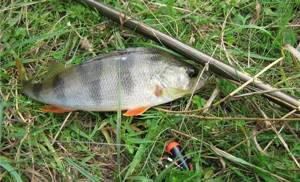
The classic game of the bulldozer is the tapping method. When feeding the equipment into the fishing zone, the load reaches the bottom. After the installation has fallen to the bottom, make two or three blows with the equipment on the ground, with a lift of no more than five centimeters. At such moments, the nozzle, in any case and with any structure of the bottom base, raises a cloud of turbidity, into which a weight is raised, about 5–7 cm, and 3–5 short throws of a couple of centimeters are carried out. During the toss, hooks with cambrics and beads strung on the shank, in addition to the visual effect of movement, also create a sound wave, which also helps attract fish. After the tosses, there is a pause of at least five seconds, at which time the bite most often occurs.
Important! During the pause, the angler's attention should be focused on the guard of the tackle, with any movement of which a hook should be made, raising the rod whip up.
In the absence of bites, the wiring is changed, experimenting - decreasing or increasing pauses, changing the levels of lifting the load from the bottom and making additional rocking of the body of the bait at the moment it hangs.
Which one to choose?
Speaking about the color of the device, the most relevant colors are:
- steel;
- black;
- copper;
- golden.
To catch peaceful species, it is worth stocking up on a design with a red and white body.
Hooks that imitate paws can be of a wide variety of colors. Don’t forget that it will be effective to string beads, washers, cambrics or silicone fragments onto hooks. This approach will allow you to modernize the device, make it more dynamic and increase catchability. I use three types of hook hangers:
- hard (beads, beads);
- soft (foam rubber, thread);
- combined (combining the first two types).
By color I choose elements of red, white, green, yellow and black. And then I combine them in different sequences.
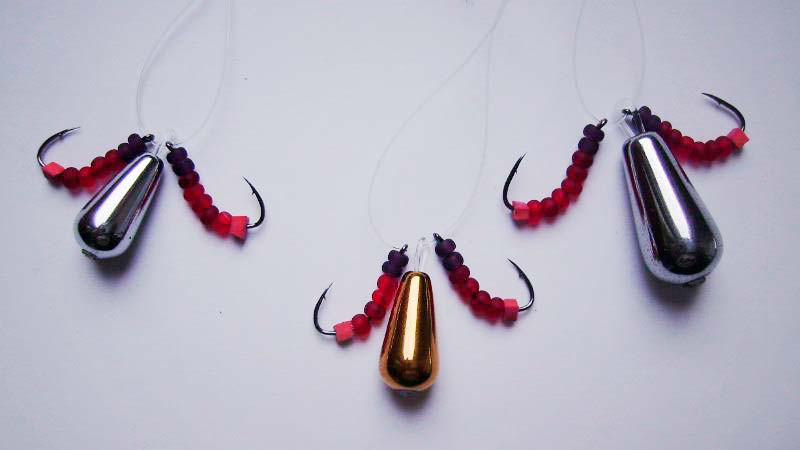
- Important! The hooks must be the same, because they “replace” the paws of a living inhabitant.
In terms of length, it is most effective to select those that make up three quarters of the body length. You can also stop at hooks that are two or three body lengths or half.
To increase strength, it is worth assembling the equipment on a fishing line. But keep in mind that in cold weather it is optimal to equip the bait with spare leashes. This will allow you to quickly change parts.
The Balda bait has one huge advantage - it can be used in snag areas of reservoirs. This is achieved due to the high mobility of each structural element. Even if the hook is caught on an obstacle, it can be released with a slight movement. In a “critical” situation, it is worth using a special cutter.
All these characteristics make the “balda” a catchy and effective bait. It is perfect for hunting not only perch, but also pike and other types of fish.
If you want to have a good time with a fishing rod, I recommend going to the Sazanya Bay fishing base. There are excellent conditions for fishing in any season. The water area of the reservoir is well stocked with fish, and you will have the opportunity, by showing ingenuity and dexterity, to become the owner of magnificent trophies.
TAGS:
How to make a balda
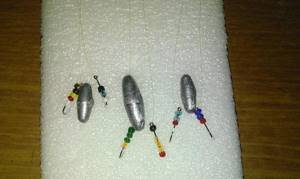
Having studied the principle of operation of the equipment, making or, as fishermen say, tying a balda with your own hands does not cause any particular difficulties even for a novice fisherman. The main difficulty in performing the work is the selection or production of the cargo required for the equipment. A weight of the required size and weight can be purchased in a store, or you can cast it yourself from lead or tin into a plaster mold, having previously provided for the installation of a fastening eyelet in the matrix immediately before casting the metal. An alternative to cast weights can be a bulldozer made of a steel, copper or brass rod, ground to the desired shape and equipped with a fastening loop.
As a rule, the loads do not need to be painted, leaving them in natural colors. In the case of painting, it is most practical to use dark colors - black, marsh green or brown, or, in extreme cases, matte silver. In addition to the weight, you will need to purchase single hooks of the required size with a fastening ring and preferably with a long shank, which are equipped with multi-colored chopped cambric and beads to give an attractive shape.
The equipment elements are threaded onto a fishing line with a thickness of 0.15 to 0.25 mm in the hook-weight-hook sequence, and a blind loop with a device for fastening the main fishing line is knitted 3-5 cm from the product elements. In some cases, in the place where the loop is knitted, you can install an additional miniature tee, which increases the fishing efficiency.
Description and types of gear
Balda is an artificial bait that is made of lead and has the shape of a cone or cylinder. The completed workpiece has a through hole into which a fishing line with two hooks is threaded. To increase the catchability of the tackle, various beads and cambrics are put on the hooks. This bait imitates the behavior of small insects and fish, which attracts the attention of a predator who attacks the bait, and all that remains for the fisherman to do is hook and bring the caught trophy to the surface.
It is customary to call a balda not only the tackle itself, but also the method of fishing using such equipment. It is customary to distinguish several types of bait, which differ in fishing technology and the shape of the bait:
- The classic bullhead is used primarily for winter fishing. This type of tackle consists of a small drop-shaped weight with a through hole and two hooks with multi-colored balls and colored cambrics attached. The bait can be made in different sizes and weights. The weight is made of lead or tungsten tin.
- Due to its versatility and catchability, the Siberian bullhead is used by fishermen not only in winter, but also in the summer. This type of tackle involves the use of a large pear-shaped and elongated lead sinker. Behind the sinker there is a so-called setup or post, which consists of a piece of fishing line with two or three short leads. Each leash is equipped with a hook with a fly or beads. Using a carabiner, such tackle is connected to a fishing line and equipped with a massive float.
- The grayling balda is an original tackle that has become widespread in Siberia. What makes this rig different from the classic version is the ability to catch fish right at the surface of the water. Thanks to the presence of large-sized floats, the lead weight and hooks with cambrics and beads attached to it through a loop are located right at the surface. Such a float not only ensures that the tackle remains on the surface, but is also used as a bite alarm.
In each specific case, varieties of this equipment are used that are suitable for a specific body of water. The most popular bait is the Balda when ice fishing, when you can catch perch, pike, pike perch, bream and other fish with this tackle.
What bait is better to use
For catching perch, the bait most often used is “bulda” or “Lithuanian devil”, or simply “egg”; the names vary depending on the region. This is a load equipped with shiny bright elements and coated with flavorings; this is not necessary, but desirable.
This gear is the most catchy for catching perch in the winter. But in addition to this, you should also take other gear for fishing, such as spoons, live bait, bloodworms, etc. There are only four main types of balda, they differ in the type of fastening. All of them are used for catching perch in winter.
Let's describe them in more detail.
- the classic version of the bulldozer is simple - a weight with two hooks at the base;
- sharaga - a conical sinker narrow at the base with four hooks at the end;
- witch or jellyfish - a conical weight narrow at the end with two or three hooks attached to the base;
- Honduras - a sinker covered with a silicone popper with two hooks on top and one on the end.
In fact, it is very difficult to say which option is best. They are all unique in their own way. For example, if the cone weight is positioned with its blunt end down, then the silt will spread under water at approximately an angle of 30 degrees, that is, not high along the bottom, but with a large radius. This bait will have a loud “splash”, which also attracts fish.
If the cone sinker is attached with the blunt end up and the narrow end down, then the silt will rise from the bottom at an angle of approximately 80 degrees upward, and the radius of spread will be smaller than that of the previous tackle. As for the “plop” sound, it is much quieter in comparison with the first option and is less noticeable to the perch, which means you will not scare the fish if it is standing very close. The choice is up to the fisherman. But it’s best to have several different bait options with you.
